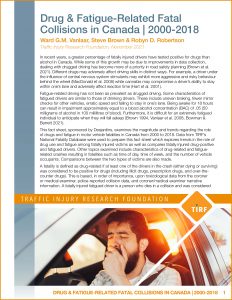
Between 2000 and 2018, the number of drug-related road traffic fatalities generally increased from 266 in 2000 to a high of 551 in 2018. On the other hand, the number of fatigue-related road traffic fatalities rose from 138 in 2000 to 159 in 2004 before falling to a low of 81 in 2018. The rise of these drug-related fatalities is in contrast to the decline in fatigue-related fatalities, particularly since 2004. While the apparent decrease in fatigue-related fatalities may be encouraging, there has been no change in terms of the proportion of all fatalities attributed to fatigue. To illustrate, in 2000, 5.1% of all fatalities were fatigue-related and in 2018 it was almost the same at 5.0%. On the other hand, the percentage of fatalities that are drug-related has risen steadily from 10.5% in 2000 to 30.9% in 2018.
“Fatigue-related driving has not been as prevalent as drugged driving, however, some driving characteristics of fatigued drivers are similar to those of impaired drivers,” explained Ward Vanlaar, TIRF COO. “These include uneven braking, fewer mirror checks for other vehicles, erratic speed and failing to stay in one’s lane.”
It’s critical drivers understand that being awake for 18 hours can result in impairment due to fatigue which is approximately equal to a blood alcohol concentration of .05. Furthermore, it is difficult for a sleepy or fatigued person to anticipate when they will fall asleep. So, even if you don’t feel tired, sleep is a biological need you just can’t fight.
In looking at the characteristics of these fatalities, results showed drug-related fatal collisions most frequently occurred between midnight and 6 a.m. and as earlier data from TIRF’s National Fatality Database and research literature has shown, fatigue-related fatal collisions occur more frequently in the early morning. For both drug-related and fatigue-related crashes, there was little variability in the percentage of drivers dying in crashes that occurred on weekdays compared to weekend crashes.
“Although drug- and fatigue-related fatalities happen all year round, the recent change back to standard time brings a heightened awareness to the issue of fatigued driving,” points out Steve Brown, TIRF Research Associate and Data Analyst.
Interestingly, the percentage of drug-related fatalities declined with an increasing number of vehicle occupants which may indicate drivers carrying passengers felt a greater sense of responsibility. However, it is concerning that drivers with three or four occupants were more likely to be involved in fatigue-related crashes than those with a lower number of occupants.
“This characteristic may require further monitoring since it would be expected that passengers can keep drivers engaged in conversation or vehicle occupants can take turns driving on a long trip,” continued Brown. “It suggests education not only for drivers but also their passengers may be effective.”
The sole fact that fatigued driving appears to be the smaller problem must not serve as a reason to divest resources away from the issue. Instead, evidence-informed decisions should be based on where to invest and prioritize to work toward Vision Zero, i.e., no fatal and serious injuries on our roads and making sure people get home safely. Resources to adopt this approach are freely available at action2zero.tirf.ca.
Download fact sheet in English & French:
- Drug & Fatigue-Related Fatal Collisions in Canada | 2000-2018
- Collisions mortelles associées aux drogues et à la fatigue au Canada | 2000 à 2018
- Visit TIRF’s Action2Zero learning centre
About TIRF
The vision of the Traffic Injury Research Foundation (TIRF) is to ensure people using roads make it home safely every day by eliminating road deaths, serious injuries and their social costs. TIRF’s mission is to be the knowledge source for safe road users and a world leader in research, program and policy development, evaluation, and knowledge transfer. TIRF is a registered charity and depends on grants, awards, and donations to provide services for the public. Visit www.tirf.ca.
LinkedIn: Traffic Injury Research Foundation & Drop It And Drive® Program, TIRF
Facebook: TIRFCanada & Drop It And Drive®
Twitter: @TIRFCANADA & @DropItAndDrive
Instagram: @tirfcanada_diad
– 30 –
For more information, please contact:
Karen Bowman
Director, Marketing and Communications
Traffic Injury Research Foundation
613-238-5235 (office)
1-877-238-5235 (toll-free)
250-797-0833 (direct)
613-238-5292 (fax)
tirf@tirf.ca / karenb@tirf.ca
